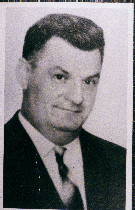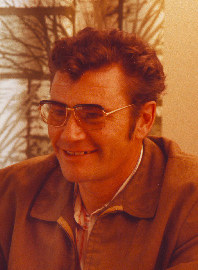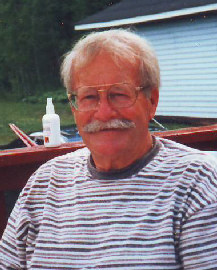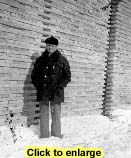


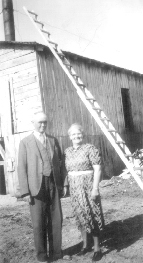
Noé Fontaine and his, wife Phébée at the Fontaine's Landing mill (Town of Hearst collection; picture donated by Mrs. Jeanine Fontaine-Guérin) |
Before
moving to Ontario, Noé Fontaine owned and operated three sawmills
in Sully, Québec, which were all destroyed by fire. In the early
20s, Noé and his family moved to Kapuskasing. Noé then built
a small sawmill north of Kapuskasing that functioned for about four years.
In 1926, the Fontaines moved to Harty where they operated a new sawmill
until 1934.
|
||||
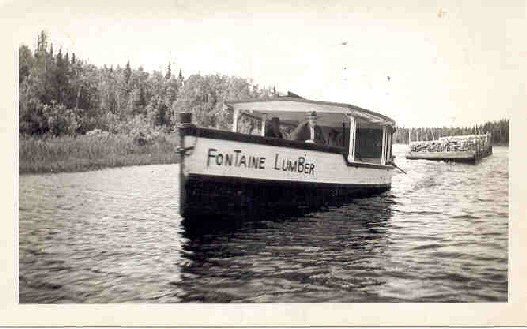 |
||||||||
|
(picture donated by Mrs. Jeanne Forcier) |
||||||||
After
obtaining the aforementioned licence the Fontaines moved their mill from
Mattice to the location that is known today as Fontaine's Landing ("Passe-à-Fontaine"
in French; the location was also known as camp 1 in Ryland). They built
camps, a store, a kitchen ("cookery") and a stable for horses. Workers
and their families spent all winter in the bush. René Fontaine explains:
"There were no roads. We went up there in the fall through the lakes before they froze and we got out of there in the spring." 1938 marked the founding of Fontaine Lumber and Timber, which included 5 owners: Noé and his wife Phébée, Zacharie and his wife Laura, and Roméo Fontaine, Noé's brother. Until 1941, lumber from the Fontaine's Landing mill was transported by truck or by train to the planer in Mattice. In 1942, the planer was moved to Hearst, more precisely to a location that is presently occupied by Villeneuve Construction's cement plant. |
||||||||
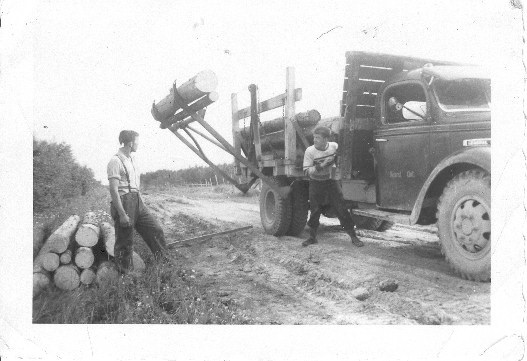 |
||||||||
|
Left: Ronaldo Fournier; right: René Fontaine (Écomusée de Hearst et de la région collection; picture donated by Mr. René Fontaine) |
||||||||
In
1941, Fontaine Lumber and Timber built a new sawmill in Lac Sainte.Thérèse,
which operated until 1955. The offices, a store, the kitchen and two dormitories
were located in front of the church. The company also built the Kabina
River mill, which was later sold to Willie Létourneau (and subsequently
to J. D. Levesque). For a few years, the
Fontaines also owned a portable mill on the west side of Nagagami River
and a mill south of Val Côté during World War II, where aspen
was sawed for export to England.
For several years, the Fontaine's Landing (Ryland) mill was operational during the winter while the Lac Sainte.Thérèse mill worked in the summer. Later, the Fontaine's Landing mill functioned year round. Lumber camps were installed along Lakes Pivabiska and Wolverine. Logging operations took place mainly in the winter. Timber was transported in winter by small tractors to the Ryland mill. During the summer, logs were loaded on to barges and pulled by boat to the sawmill. Wood from Pivabiska Lake was transported to the Lac Sainte.Thérèse mill and wood from Wolverine Lake to the Fontaine's Landing mill. After Noé Fontaine's death in 1946, Zacharie Fontaine took possession of Fontaine Lumber and Timber. Starting in the 1950s he received the help of his son René. In 1954, they closed the Lac Sainte.Thérèse mill and increased production at the Fontaine's Landing mill. They built the Fontaine's Landing road in 1957. René Fontaine bought his father's mill the following year and, after 20 years of operation at Fontaine's Landing, moved the machinery north of Calstock on Roger's access road, after having obtained logging rights in that area. He operated the sawmill under the name Polar Lumber. Zacharie remained responsible for the Hearst planer. |
||||||||
 |
||||||||
|
(Town of Hearst collection) |
||||||||
 |
||||||||
|
(Écomusée de Hearst et de la région collection; picture donated by Mr. René Fontaine) |
||||||||
In
1964, René Fontaine undertook the construction of a new sawmill
in Hearst. The mill was operational the following year, coinciding with
Zacharie's death. René Fontaine then partnered up with Émile
Joanis, his brother-in-law, who had previously purchased logging rights
owned by Arrow Timber, an American company. They formed the F. & J.
Lumber (Fontaine and Joanis) company. Following Émile Joanis' accidental
death in 1968, his widow, Lauryanne, took charge of the company.
In 1969, Roland Cloutier left Levesque Lumber to become partner and manager of Arrow Timber. The same year, Réal Levesque, owner of Hearst Transport & Lumber, joined René Fontaine, Lauryanne Joanis and Roland Cloutier to form the United Sawmill company. However, the following year, Réal Levesque left United Sawmill to take over Levesque Lumber from his father, J. D., who was retiring. Charles Lecours, owner of Deep Forest Products, bought out Réal's shares in United Sawmill.
In
1982, the companies, which up to this point had operated separately, united
to operate under the sole name of United Sawmill Co. Ltd. In 1990 the company
was sold to Malette Inc. of Timmins. Malette was subsequently bought by
Tembec Inc. of Abitibi in 1994.
|
||||||||
